Hello and welcome to today’s edition of Kitchen Projects! Thank you so much for being here.
Today I’ve got a beautiful savoury bake for you: A pumpkin torta, a thin crispy double crusted pie inspired by the Italian tortas, which puts gourds at the forefront. Over on KP+, I’ll give you a salad to enjoy with the tart and another use for that pumpkin puree: Caramels! Click here for the recipe.
Kitchen Projects is 100% reader funded; By joining KP+, you will support the writing and research that goes into the newsletter and get access to extra content, community chat threads, and more. Subscribing is easy and only costs £5 per month:
Alright, let’s do it!
Love,
Nicola
A pumpkin moment
Right now, the world is alight with gourds, squashes, and pumpkins: All things that feel very autumnal. But it’s a big world out there, and with so many shapes, sizes, flavours, and colours to contend with, it can be hard to know where to begin. I know I feel bamboozled.
My first run-in with pumpkin this year, actually, was in Liguria a few weeks back, in the form of a savoury ‘Torta’. When we stumbled into the Antico Forno Della Casana bakery in Genova, we were greeted with such a joyful display of seasonality: The pumpkins had definitely arrived. Along with herby rice tortas, I was entirely enamoured by the orange ‘Torta di Zucca’. In Italy, a torta is a savoury pie with thin pastry, with fillings that change from season to season.
I have to say: One of the things I really appreciate about Italian bakeries is the outrageous scale of everything. In the UK, everything seems to be a maximum of 8 or 9 inches wide. In Liguria, the torta must have been half a metre wide! And I loved it. We picked up a slice and took it with us on the train:
The simplicity was admirable - the rich pumpkin flavour was tempered with a little egg for a fluffy texture, and not much else, as far as I could tell. It was just so delicious. Immediately I knew it was something I wanted to bring to the newsletter. From something you can throw in your bag for lunch or serve at a dinner party with friends, today I’ve got such a cracking autumnal recipe for you in the form of my pumpkin and parmesan torta. Enjoy slices on their own or serve with an acidic bitter-leaf salad.
How to pick a pumpkin
Having worked in various kitchens over the years, I know that you should be selecting your pumpkin with two things in mind: Water content and sugar content. Both of these will impact the texture and flavour. But how are we supposed to know the lay of the land? How do we know which pumpkins we can trust? I genuinely feel a bit of anxiety when it comes to picking between all the gourds.
I started off the week by going to my local greengrocers and picking up several types. I cut them in half and roasted them off to see how they would behave in the oven:
‘A’, with its low-wide profile and dark skin and golden flesh, was definitely of the kabocha variety. This means it’s a shoo-in to have dense, rich flesh.
‘B’ was decent, but the seed-to-flesh yield was shameful - after cooking, the flesh itself was quite nutty and rich but very bitter.
Sadly a lot of pumpkins are grown only to be carved or decorated! That is almost certain in the case of ‘C’ is almost certainly a carving pumpkin which means it has spongy, flavourless flesh.
‘D’, though it looked promising, was the worst of the lot. I can’t tell you how haunted I felt by this pumpkin - the flesh was watery, fibrous and utterly horrifying! I also roasted all the small pumpkins - not one of them was delicious alone, and I can see how these might be better off as decor or stuffed.
After roasting, it was clear which were goers and which were not. But I didn’t feel that much more confident about how to pick a pumpkin, nor could properly identify them… So, when in doubt… what to do? Seek out an expert, of course!
I’m fortunate enough to be acquainted with Ally Young former chef and the head of procurement for Solstice, a North London-based fruit & vegetable supplier. I’m also nicknaming him LORD OF THE GOURD because his pumpkin knowledge has been absolutely on point. Solstice was started in 1997 by an ex-Michelin star chef with a strong focus on only sourcing the best from the UK, Europe and beyond. After roasting my various pumpkin and squash and being a mixture of shocked/surprised/saddened at the results, Ally swept in to save the day and was able to identify and give a bit more context on all the varieties. He’s provided us with a guide to spotting and storing squash this winter.
A guide to squashes and pumpkins
by Ally Young
Casperita / Acorn
Mainly for decoration. The skin softens whilst cooking but can be bitter. The flesh is mild in flavour and a little creamy. Low yield once seeds have been removed.
Harlequin Squash
A pretty little thing. It can be orange, yellow, white or green. Larger than an acorn. Fibrous with lots of seeds. Very low yield when roasting, better for stuffing/ setting
Delicata Squash
Sweet and mildly nutty, with smooth, creamy flesh. A hint of sweet potato about it. Skin breaks down when roasted but should be peeled if steamed/ boiled.
Onion/ Pottimarron
Usually tear-drop shaped (similar to an onion, hence the name) but can be more elongated, with rough orange skin, a large cavity and a thin layer of orange flesh. Holds up well after roasting and is not overly sweet. Versatile and mild.
Iron Bark Pumpkin
Very tough, deep-ridged outer skin with rich, dense orange flesh, which can be fibrous. Low water content and stores very well. Works well in both sweet and savoury applications.
Delica/ Kabocha
High sugar content and strong, nutty taste. The fruit is cured to reduce water content and intensify the flavour. The texture of the flesh is light and smooth. Skin can be kept on for roasting but won’t break down fully. The taste is almost chestnutty, and the sweetness intensifies after cooking.
Editors note: According to Ally, this curious curing is the process when the growers allow the pumpkins out to dry for several weeks - or months - to harden the skin and dry out the flesh. This results in improved sugar content and super-dense final texture. Think of it like the pumpkins going to a spa. As well as improving the flavour and texture, it also preserves them, giving them a longer shelf-life!
Field/ Halloween Pumpkin
Grown mainly for decoration. Mild in taste and balanced sweetness with a high water content. It may need to be strained through muslin if using the puree, as water can leach out and dilute everything around it!
Additional mentions not in group shot….
Crown Prince Pumpkin
Smooth, light blue/ grey skin and yellow/ orange flesh. Low water content and almost “waxy” texture. Medium to mild sweetness. A good all-rounder.
Spaghetti Squash
It can be yellow and orange. So-called for its fibrous, “spaghetti-like” texture when cooked. High water content and a mild, slightly sweet flavour.
Notes on Storage
Iron Bark, Crown Price and Delica can be stored whole at around 10C in a cool dark place for 10 days – 2 weeks. Store in the fridge if cut, and cover the cut side with cling/ wrap. High water content fruit like the Delicata and Spaghetti won’t keep for as long as their dryer cousins and may start to shrivel/ wrinkle if stored for too long. Decorative and Halloween/ field pumpkins don’t need to be refrigerated.
Thank you so much to my pumpkin correspondent, Ally! @Solsticefood
Before we get on with the rest of the newsletter, I just wanted to double down on my love for any fancy Italian pumpkins - they really know what they are doing when they grow and prepare pumpkins over there! They’ve been mentioned above and in previous KPs, but these fancy Italian pumpkins are members of the Kabocha squash family and are officially called ‘DELICA’ pumpkins.
As well as their low wide profile and dark green skins, they often have a special red wax top with a DOP style mark or tag on it - I even picked up one with a SPARKLY top, so I was pretty confident it was going to be good (it was. SO dense and sweet!). These outrageous pumpkins are so sweet and dense that they may as well be cake. However, they can be expensive.
Also, if seeking out a pumpkin sounds like too much work, or you don’t have a good supplier near you - I’m genuinely a fan of the butternut squash. The flesh is slightly gritter and a bit denser, though it misses an earthy flavour.
SO, in conclusion, if in doubt, look for a low wide dark-skinned pumpkin - this is most likely going to be a kabocha = a high chance of a good flavour. Or a ‘crown prince.’ As Ally says, “Thicker, gnarlier skin in dark green or orangey red will be all-rounders, if slightly sweet!”
What do to with watery pumpkin
So you’ve done everything you can to select a good pumpkin, but after roasting and mashing, it’s still a bit watery a flavourless, what should you do? Well, you have a few options. Firstly you can try and remove as much water as possible by letting it sit in a fine-meshed strainer or muslin, letting gravity do the work for a few hours. You can also expedite this process by further reducing the puree in a low wide frying pan or even in a low oven - for a frying pan, I would say this takes about 20-30 minutes, depending on how much water there is. In the oven, you’d be looking at 130c for about an hour, moving it around occasionally. This reduction process will remove even more water and intensify the flavour. That being said, it is a lot of work. Personally, I would prefer spending an additional hour looking for a good pumpkin than spending an extra hour fussing over an average puree, but I know we all have different suppliers and options!
KP x sweet pumpkin bakes
You know me. You know I love a sweet pumpkin recipe. But now it’s been two years of dessert pumpkin recipes on KP, and it’s time that I paid a bit of attention to the savoury side of things. If you fancy something sweet, though, here are a few recipes for past pumpkin delights:
Pumpkin caramels out on KP+ today!
Potato rolls - ok, this isn’t actually a pumpkin recipe but it could easily be made with pumpkin puree rather than potato, and you’d get GREAT results.
The filling
Ever since gobbling down that savoury torta di Zucca on the train a few weeks ago, I knew that I wanted to create a savoury pumpkin recipe for you in the newsletter. I loved the way that the pumpkin was incorporated into the filling rather than just being sliced on top.
When it comes to incorporating savoury fillings in the UK, quiches and savoury tarts tend to have a pretty set formula: Make a rich custard, then fold in the (usually pre-cooked) fillings. There’s nothing wrong with this approach, but there is something to be said about creating a cohesive mixture that combines the flavour into the filling directly. Why are we always keeping things separate?!
Mixing up the filling was a bit of trial and error - since we are not looking for that ultra-smooth wobbly custard, egg coagulation and the ratio is less important here. To create a great quiche mixture that stands sleekly on its own, careful attention needs to be paid to both the formula and the baking temperature to prevent curdling. But for this pie, I wanted to make something that could withstand a higher, longer bake and didn’t need to be fussed over so much. That means we don’t want too many eggs - since this torta is cooked at a high temperature and for a long time to ensure crispy pastry, too much eggs + heat = rubber!
Based on the Italian torta di Zucca I’d tried, I knew there needed to be eggs and pumpkin in some form. Eggs, as well as bringing flavour, give a bit of structure to the pie and some much-needed body to a fairly one-note puree. Parmesan brings flavour and salt to the whole affair - using parmesan as seasoning is an elite move and adds a slightly undefinable richness when you eat it. I was also intrigued if Ricotta would give that light texture I so adored in the original. I also had some caramelised onions in the fridge - onions and pumpkin are a happy pairing, so it is worth trying this combination out too. Unfortunately it was just overwhelming.
Overall, I loved the lightness of the ricotta filling and this was the best all rounder. I loved the pure pumpkin and egg version, but the ricotta brings a lightness and texture that is centrepiece worthy. I’ve also lowered the egg to relatively low 15% overall - this helps create a bit of set but helps us avoid that overly coagulated texture. To bump up the pumpkin overall, for the final tart I've added a layer of thinly sliced pumpkin so you get some of that pure flavour along with the ricotta-parm joy.
The pastry
Please look away if you are an Italian baker because I’m probably going to offend you. I’m not a big fan of the savoury tart pastry that you find in typical Italian bakeries - you know, the type, a little bit pale and powdery, probably olive oil based. Look, I’M SORRY! It tastes good, but I’m just not that accepting of a pastry that doesn’t have some level of shattering or flaking. It’s just the way I was raised, ok? Take it up with my mum!
For today’s recipe, we are moving a bunch of the complementary pumpkin seasoning (black pepper! Sage! thyme) into the pastry itself. Today’s formula is a meditation on the classic rough puff, also known as a flaky pastry or blitz pastry. It’s a quick, semi-slap dash version of puff pastry, the labour-intensive pastry that requires you to fold butter carefully into a dough, turning and folding it until many distinct layers have formed. Rough puff is extremely satisfying to make and eat, and the effort-to-reward ratio is extremely good.
But that olive oil flavour IS good, and since this is a homage to that Italian train snack, I wanted to give it a go. I tried out a classic buttery puff and an olive oil dough:
Rough puff, with chunks of butter suspended throughout, is flaky after because of steam - when baked, these turn to steam and leave little buttery pockets behind in the baked pastry, which easily flake apart.
Because olive oil contains no water, there is no steam created in the oven as it evaporates - this means that a typical 1:1 replacement butter for olive oil in a dough cannot be flaky. It simply will not give us those airy, crispy pockets that shatter in our mouth when we eat them. Olive oil is pretty good at preventing gluten from forming by coating the flour when mixing, which does make the dough tender, but it’s no good at creating layers.
It’s possible to create a flaky pastry using oil, as is favoured in Chinese bakeries, but it is a slightly more complex process that requires two doughs (a la invert puff pastry) and quite a lot of technique. Whilst we’ll cover that one day, it wasn’t suitable for today’s recipe.
Predictably the butter pastry was delicious but actually rose a bit too much! So, what to do? HYBRID! I love nothing more than smashing two recipes together and today’s olive oil rough puff is just that. You get all the flavour benefits and tenderness from the oil but don’t miss out on any of that brilliant flakiness.
The deal with pumpkin seeds
Look, I really tried. But for me, pumpkin seeds in their shells aren’t great to eat, and they are really difficult to shell yourself - the tough outer coating is highly fibrous and not that pleasant to eat. I tried to incorporate it onto the crust and into the galette, and whilst I think it looks great, I’m not confident that the eatability was there. Even after roasting for an hour, the seed hulls are not very delicious. I think they would work better as a standalone snack as long as you were mentally prepared to chomp down on something pretty hard.
The format
Going into this week, I wasn’t quite sure of the final form. There were two main options: Open or closed. For the former, I really do love a galette, that classic flat, open-faced pastry, but is it… a bit boring? I’m not sure. I loved the idea of a low-profiled double, crusted savoury torta with a bit of galette des rois / pithivier energy without the faff.
And the result is: You do you. I’m sharing the technique for the free-form double-crusted today because I think it looks beautiful but if you prefer something open-faced, go for it! Simply skip the top layer of pastry and get all arty! The bake time should not be affected.
Ok, let's make it!
Pumpkin, parmesan and sage torta
Serves 6
Sage flaky olive oil pastry
230g plain flour
120g fridge cold butter
40g olive oil
5g salt
10g white wine vinegar
75g ice water
5g sage, chopped finely
5-8 sticks of thyme, leaves removed
Pumpkin filling
225g mashed pumpkin / puree
200g thinly sliced pumpkin (keep this aside before you roast it!)
55g whole egg
110g ricotta
40g good parmesan
1 tsp salt, plus more for flavour!
Lots of black pepper - about 100 twists!
Plus egg wash and sage leaves for the top
Method - Pumpkin Puree and filling
First keep around 250g pumpkin for slices for the top of the torta. Then roast the rest cut face down on a baking tray with parchment.
Bake at 180c for 40 mins until very soft. A knife should easily pierce the flesh
Allow to cool completely. Remove the flesh. For the pie, smash it up with a fork or if its really dry and lumpy (as some delicas) whizz it through a food processor. For sweet applications, puree through a food processor and pass through a sieve, twice, if you can be bothered
For the pie filling, add the ricotta, parmesan, then check the seasoning. When you are happy, mix in the egg. I don’t mind eating raw egg, so i like to check the seasoning again, but it is now ready to use.
Method - Pastry
Weigh out ice water and vinegar. Set aside in fridge until ready to use.
Weigh out flours, salt and herbs. Mix with paddle until all combined.
Add in cubed butter and mix on a low speed until the butter is in irregular sized pieces - you want some to be breadcrumb style and some to still be large - around 1.5cm. Then add the olive oil and paddle until well distributed, about 10 seconds.
Immediately add in your cold water/vinegar and mix until it looks hydrated - about 20 seconds. You will still have dry bits at the bottom of the bowl
Move onto a clean surface and add flour if you need to underneath
Roll the pastry out to be 40cm long and perform a double fold - this is when you fold both edges into the middle and then fold it over itself again
Perform two more double folds, immediately, adding flour when you need
Chill in the fridge for 1 hour before using
Assembly
Divide the pastry into 1/3 (about 150g) and 2/3. Reserve the smaller piece in the fridge. Roll out the pastry using firm strokes of the rolling pin, turning it a quarter turn between each roll to keep it in an even shape. Roll it to about 3mm and about 12 inches wide.
Use a cake tin to make a rough mark in the middle of the pastry to guide the build of the free-form torta. Spread the pumpkin mixture out evenly
Thinly slice around 200g of pumpkin (about 1-2mm!) and toss with 1 tsp olive oil then layer on top of the pumpkin ricotta mix. Grate a layer of parmesan.
Place in fridge whilst you roll out the other sheet of pastry to around 3mm thick and 9 inches wide.
Lay the pastry on top of the pumpkin, trim if required, then egg wash. Trim any excess pastry before folding the base up over the top in a slightly pleated but overall rustic fashion. Egg was the top and decorate with small sage leaves. Chill in fridge for 1 hour or in the freezer for 20 minutes before baking
Pre-heat oven to 200c fan. Turn down to 175c fan and bake for 40-50 minutes until golden.
Serve with a salad - formula for a lovely winter orange and radicchio salad click here





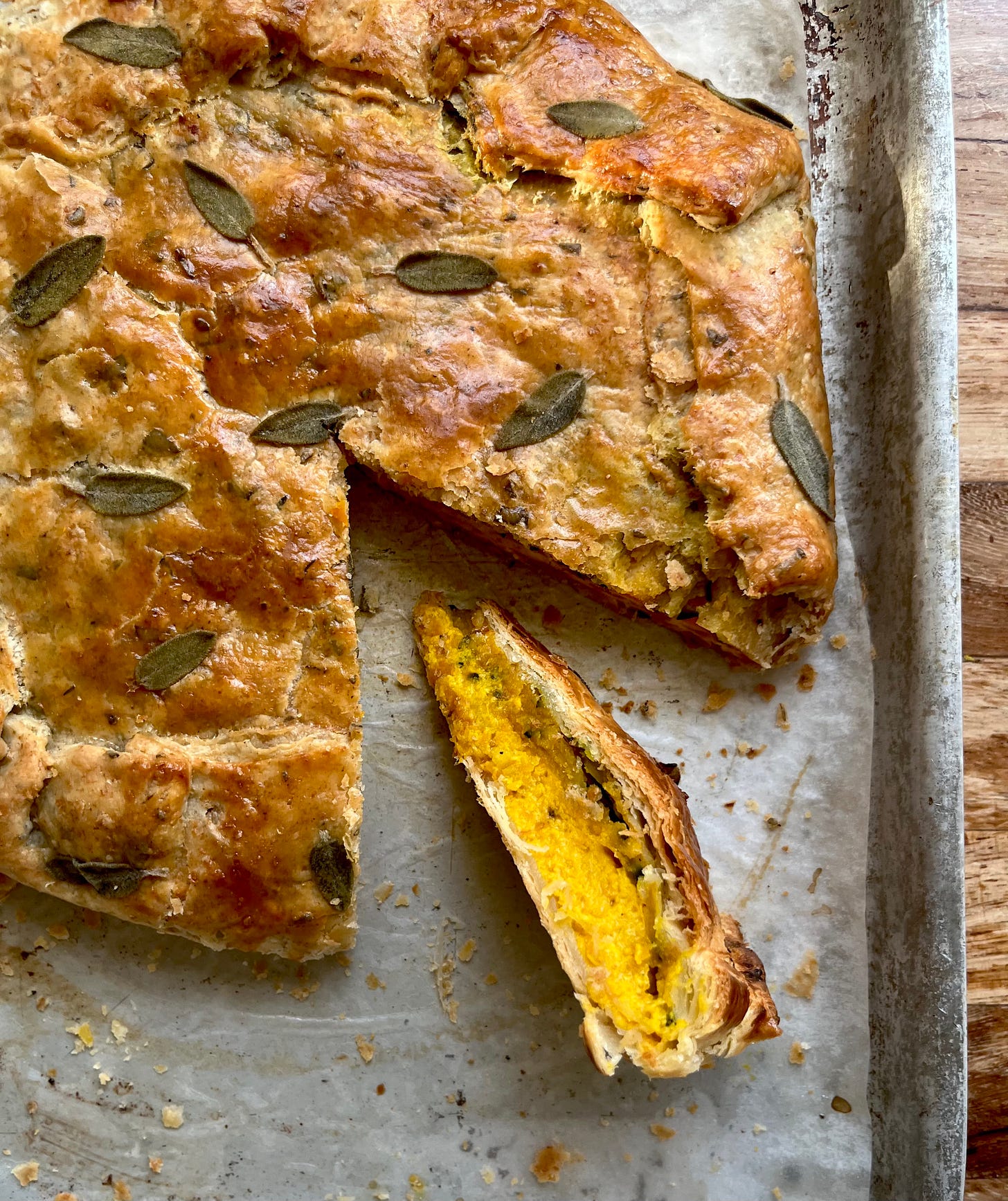

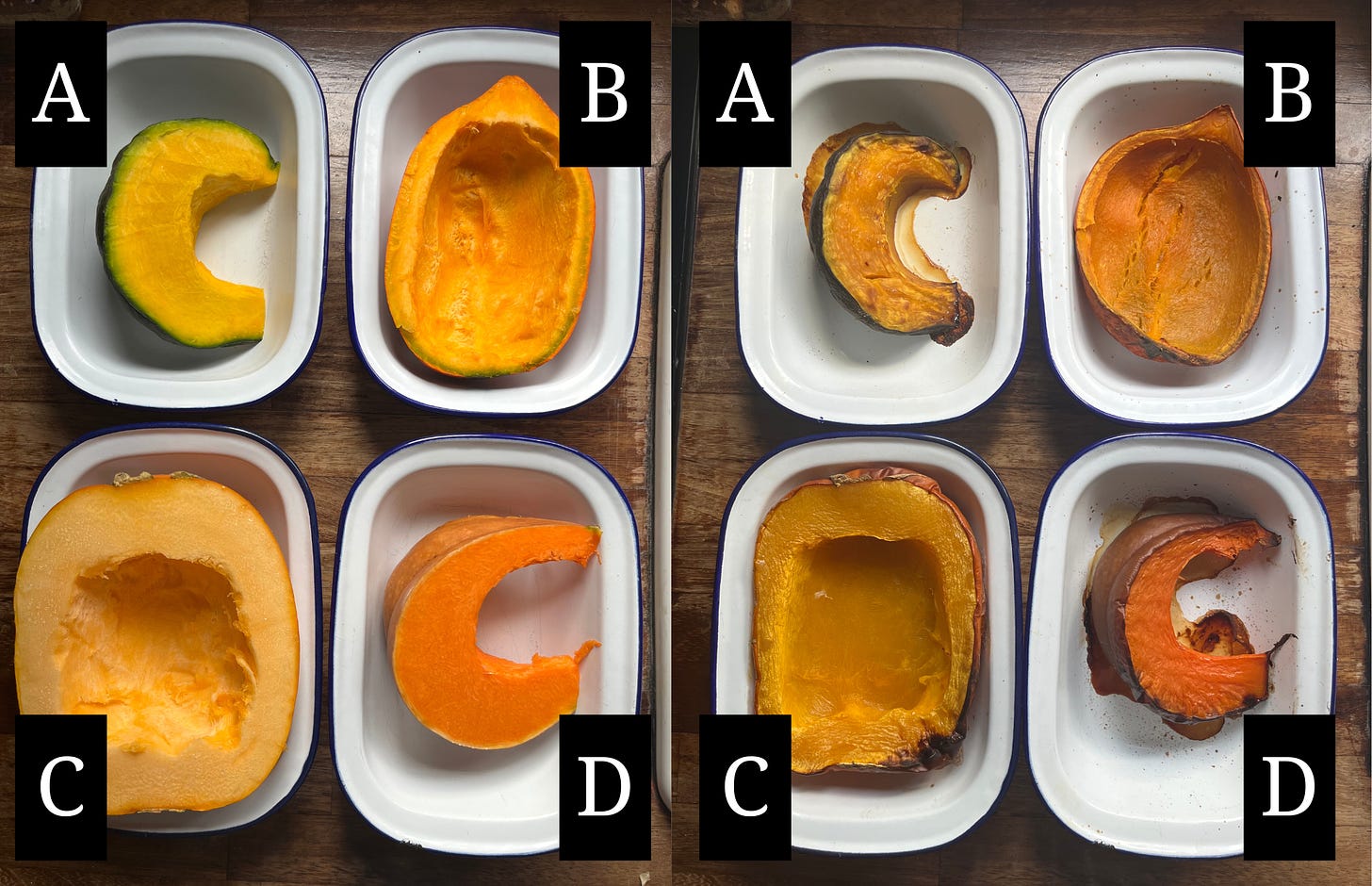

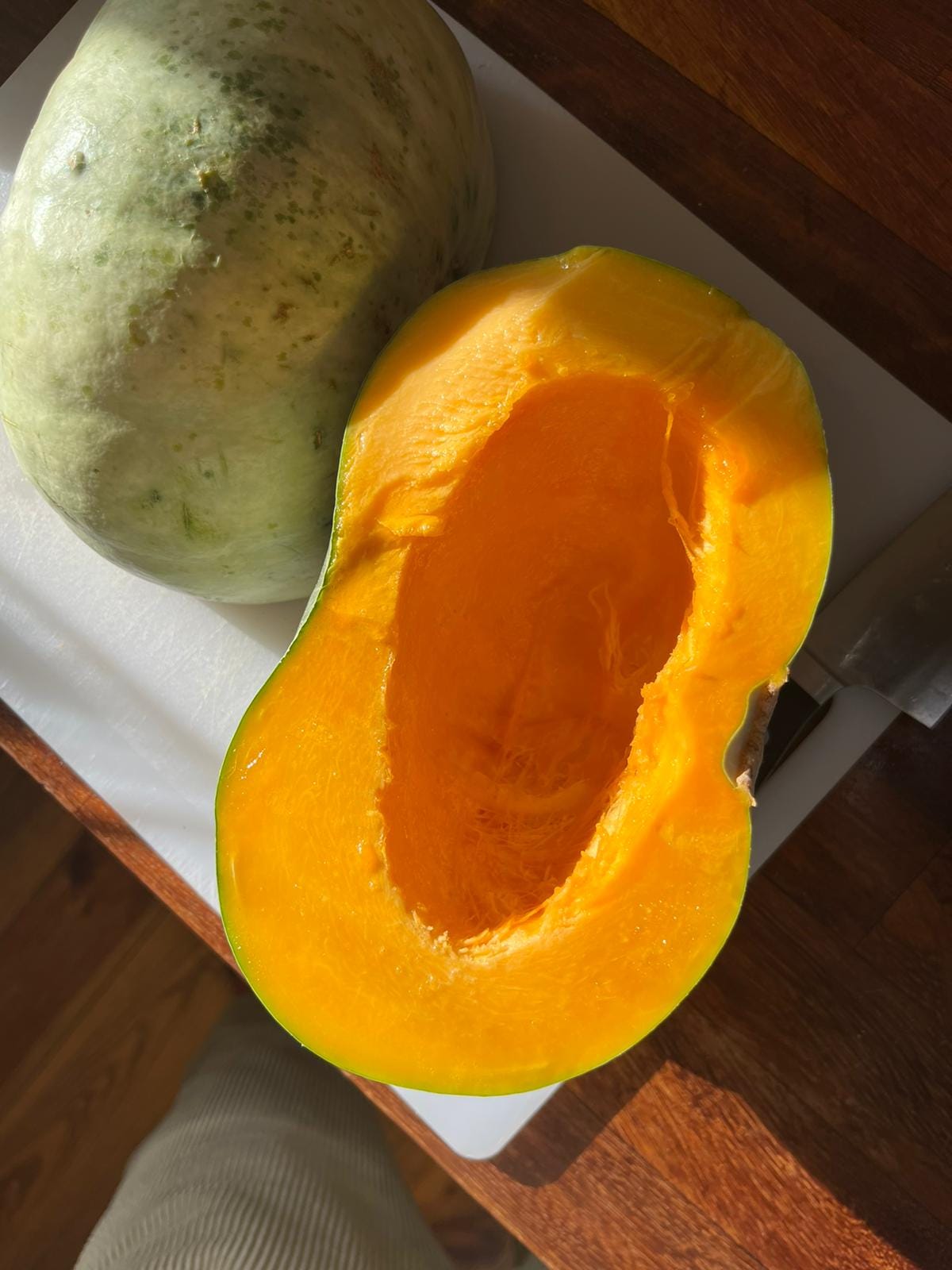
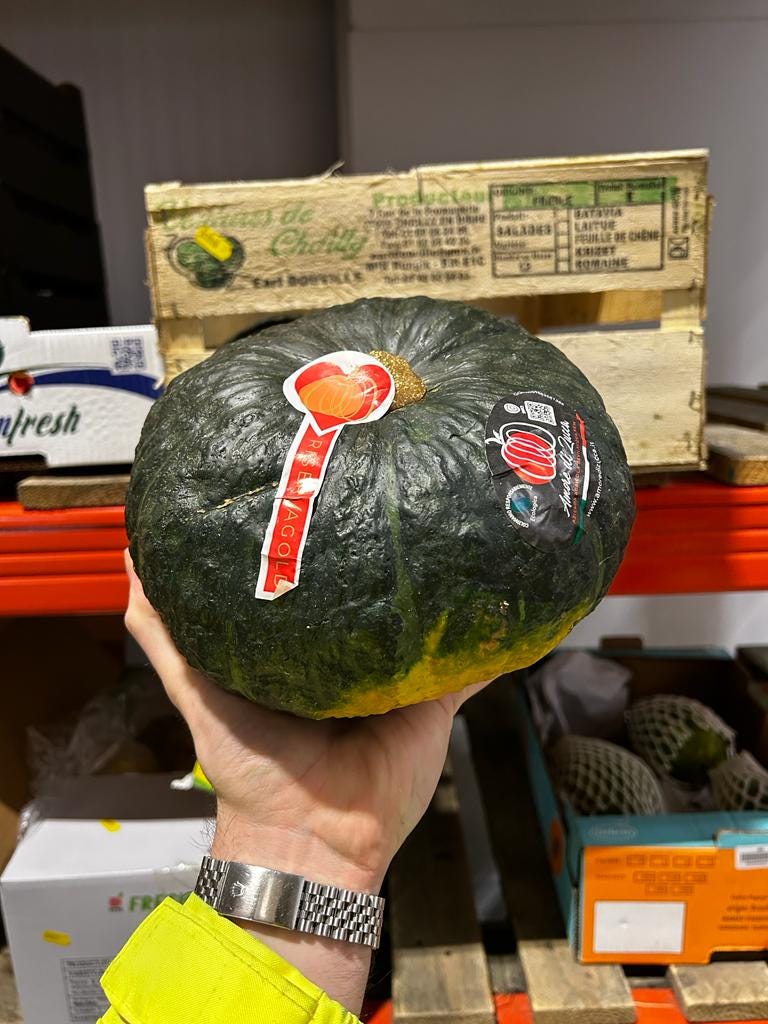
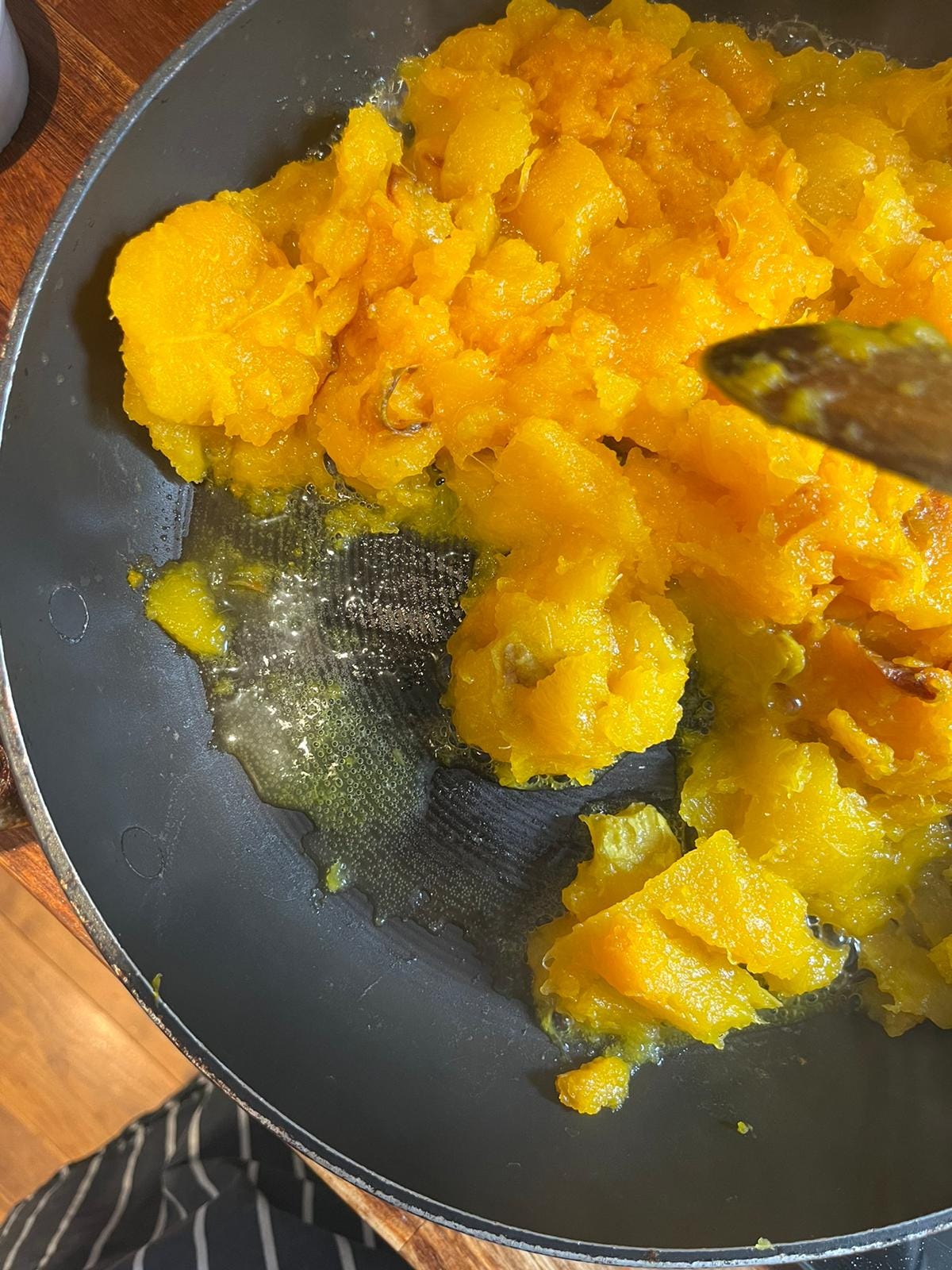
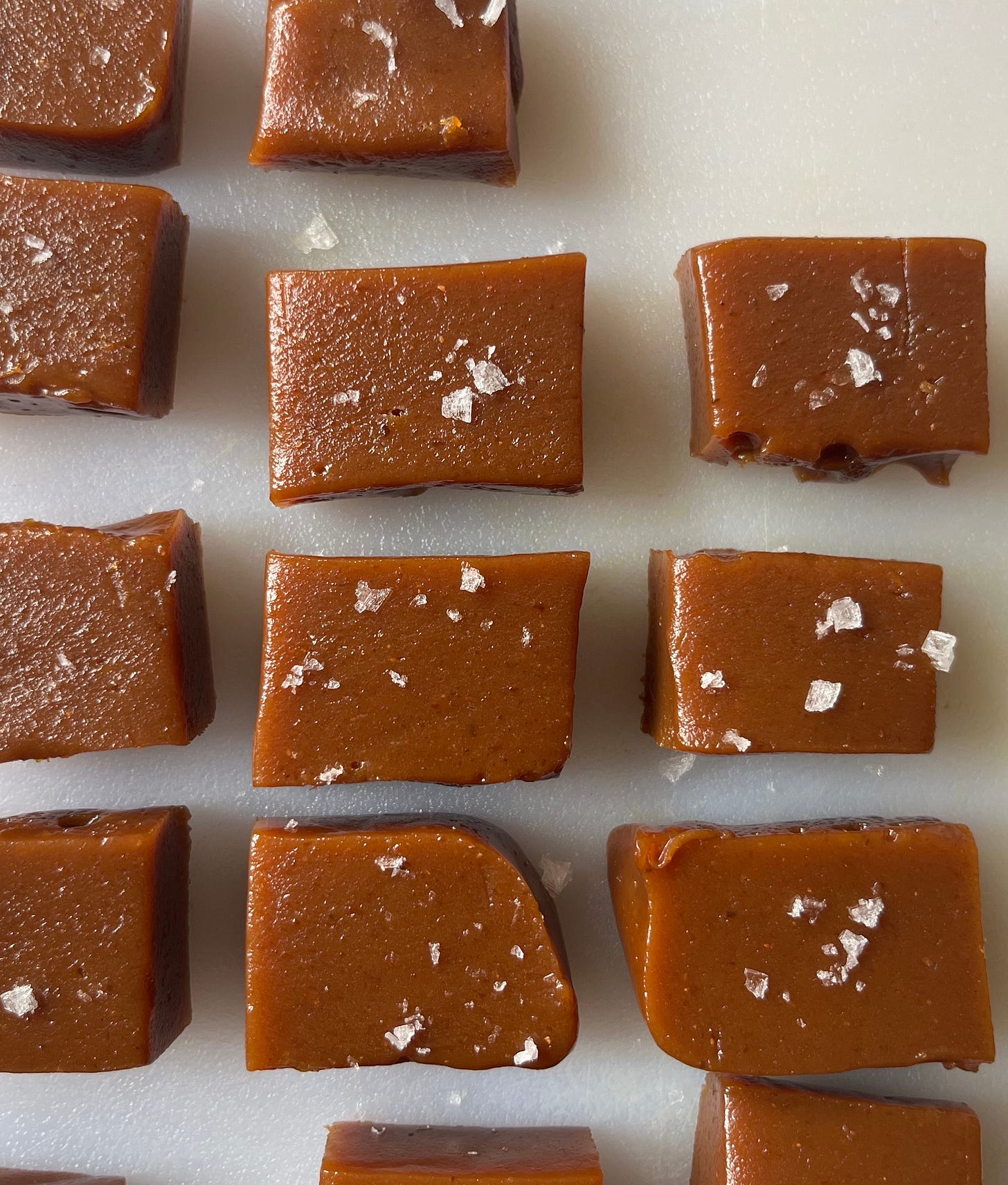

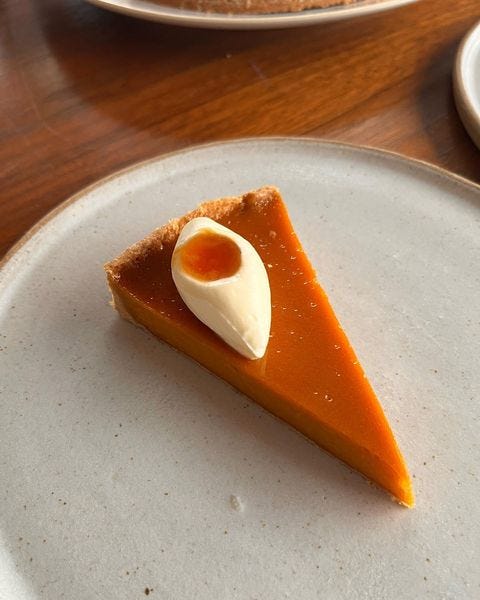
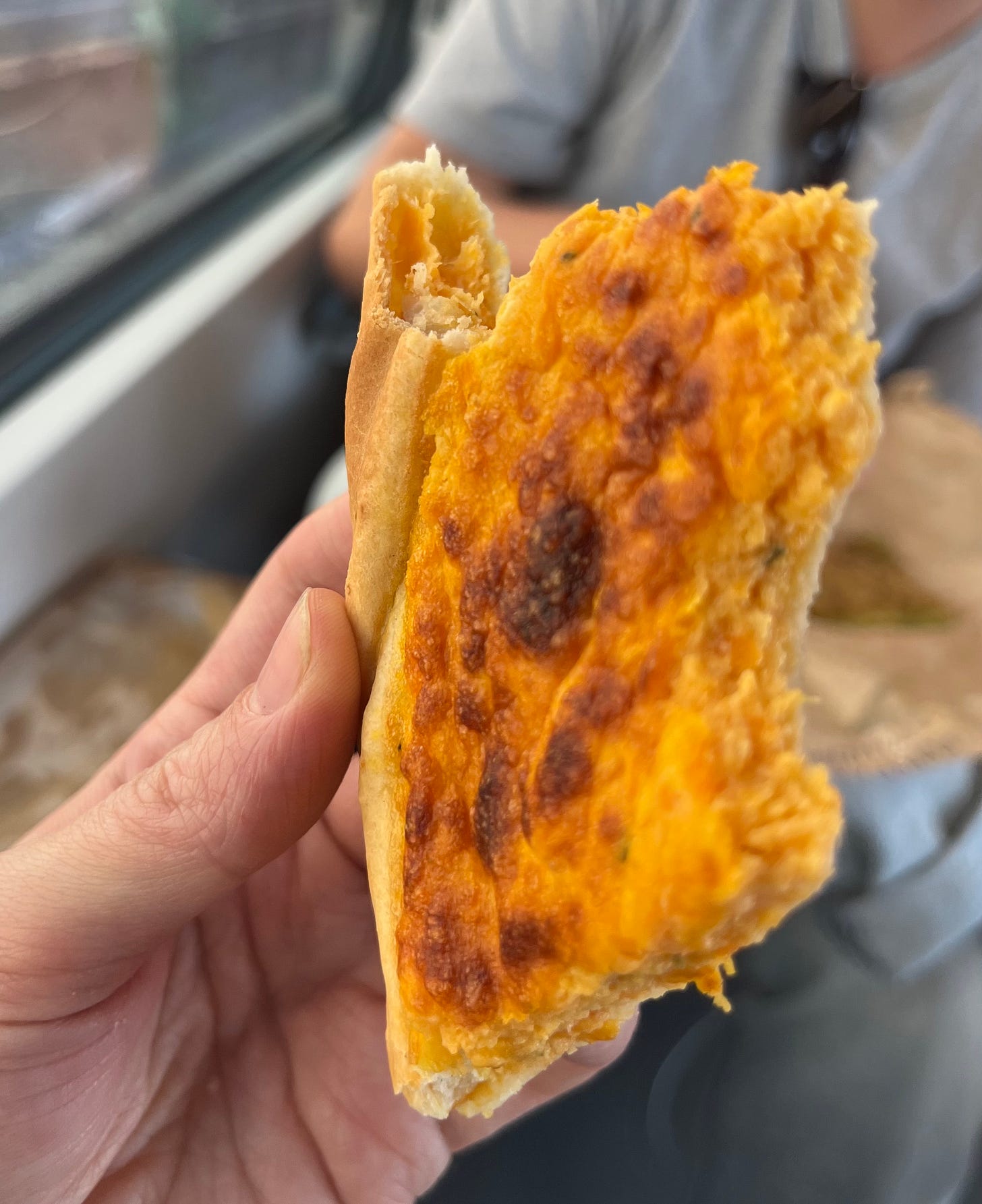
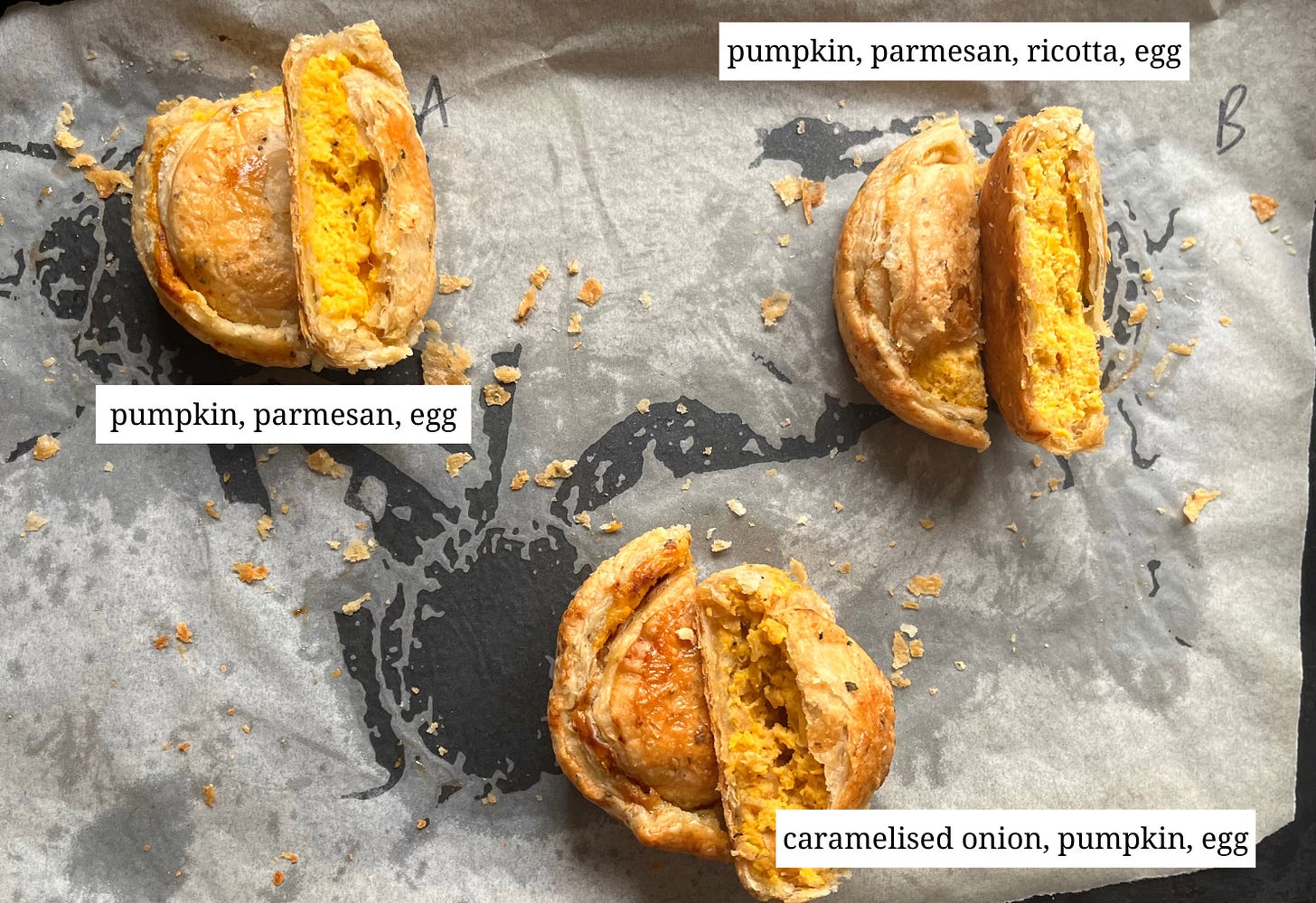
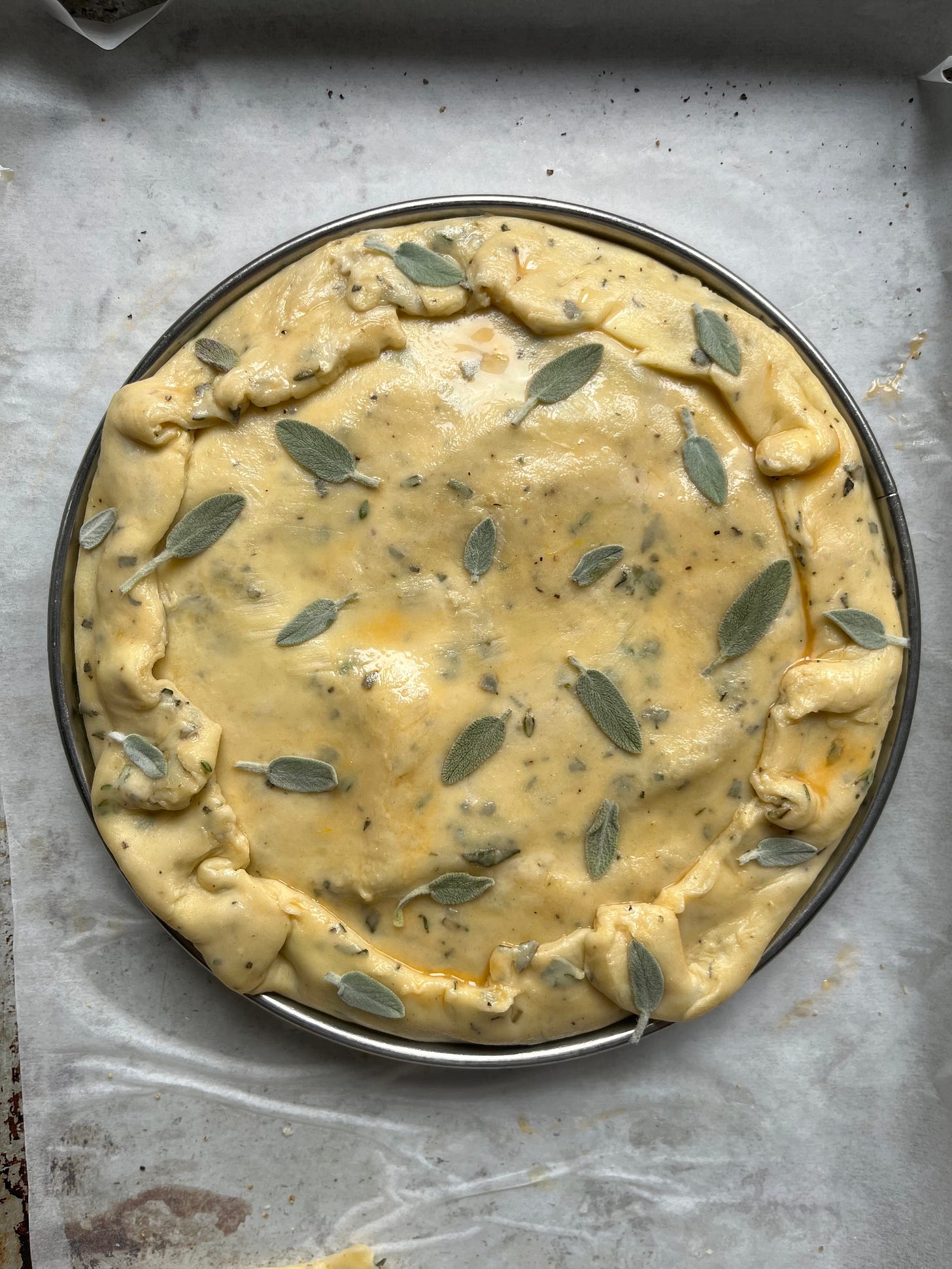
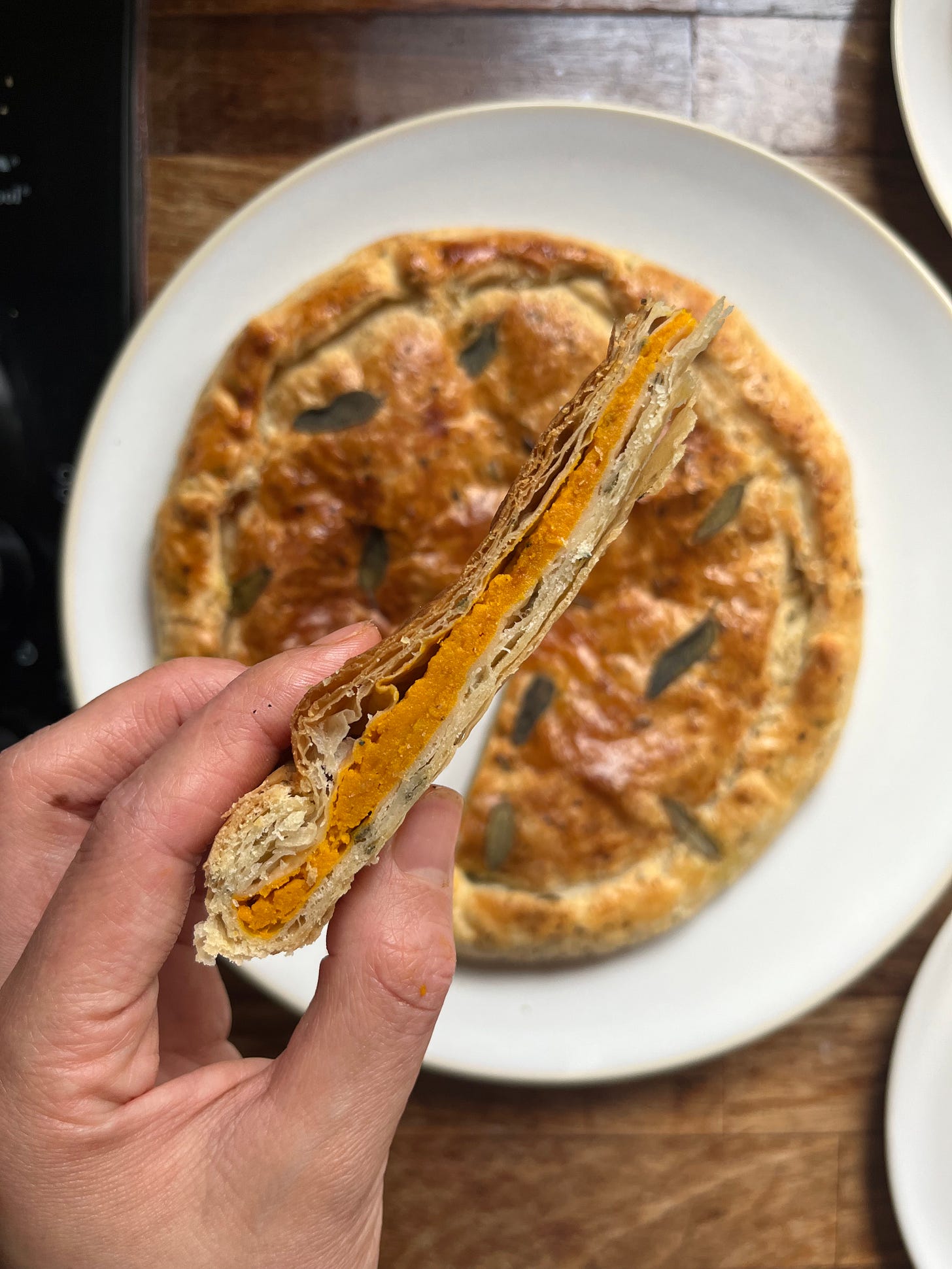
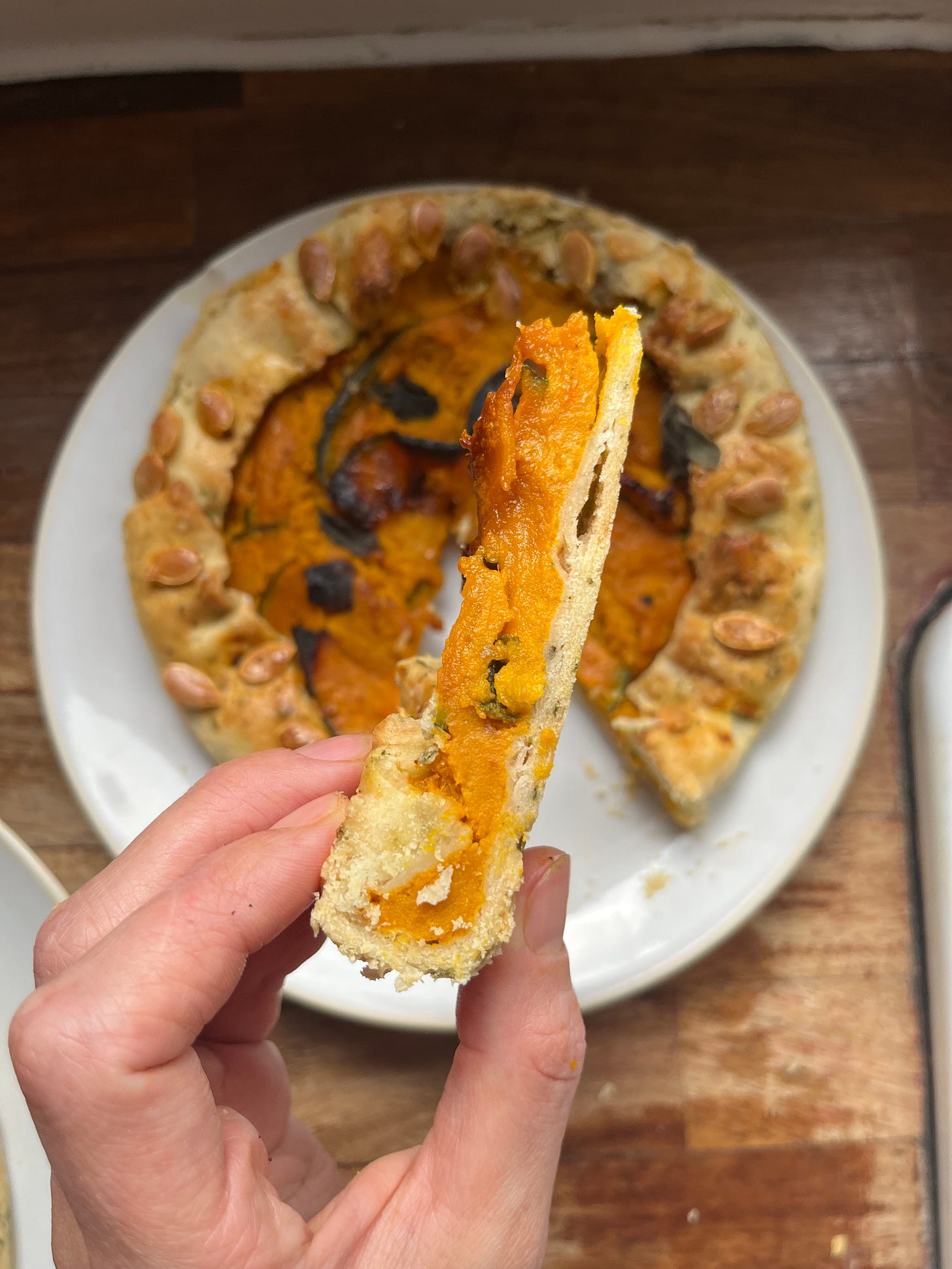
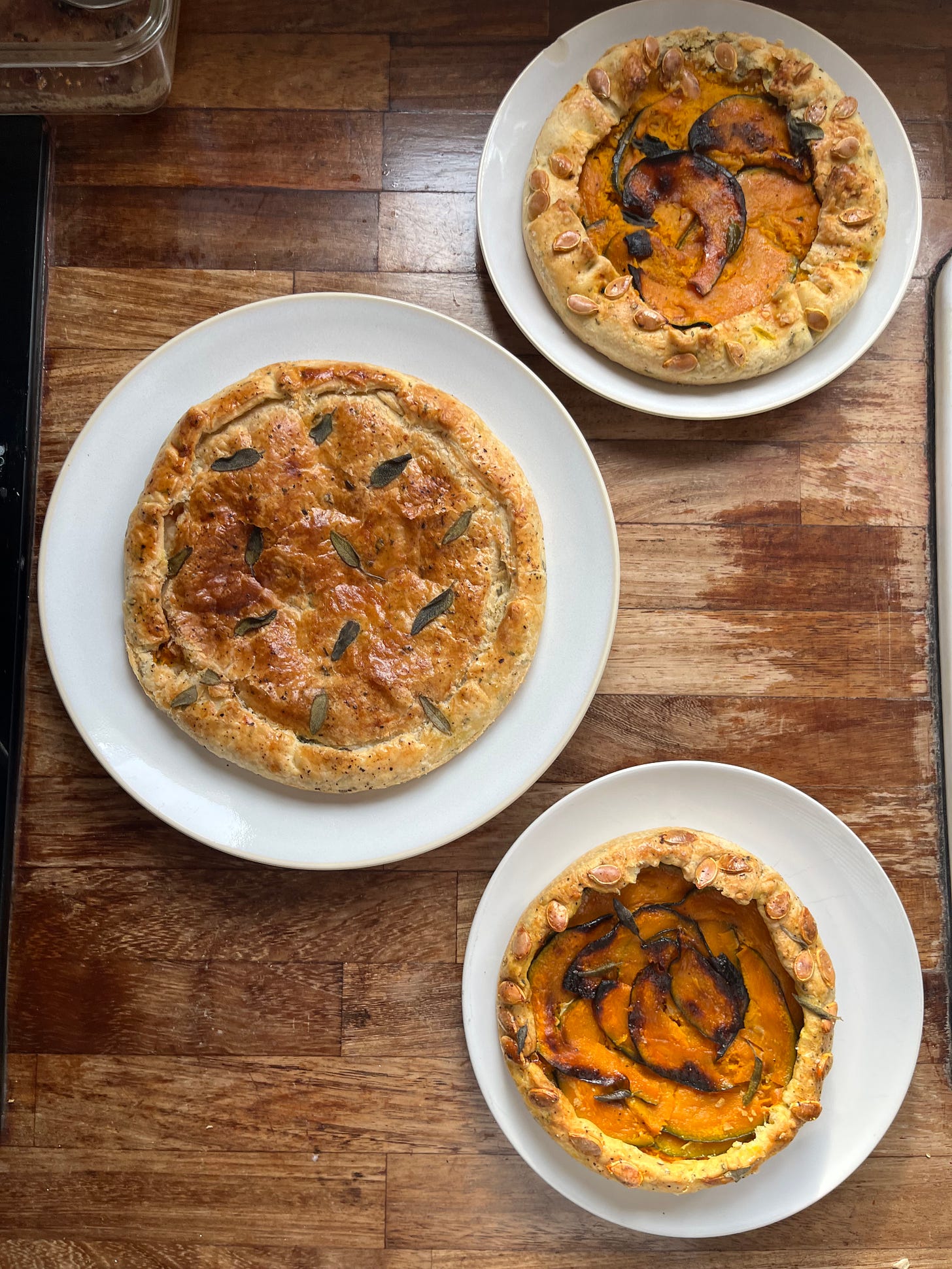
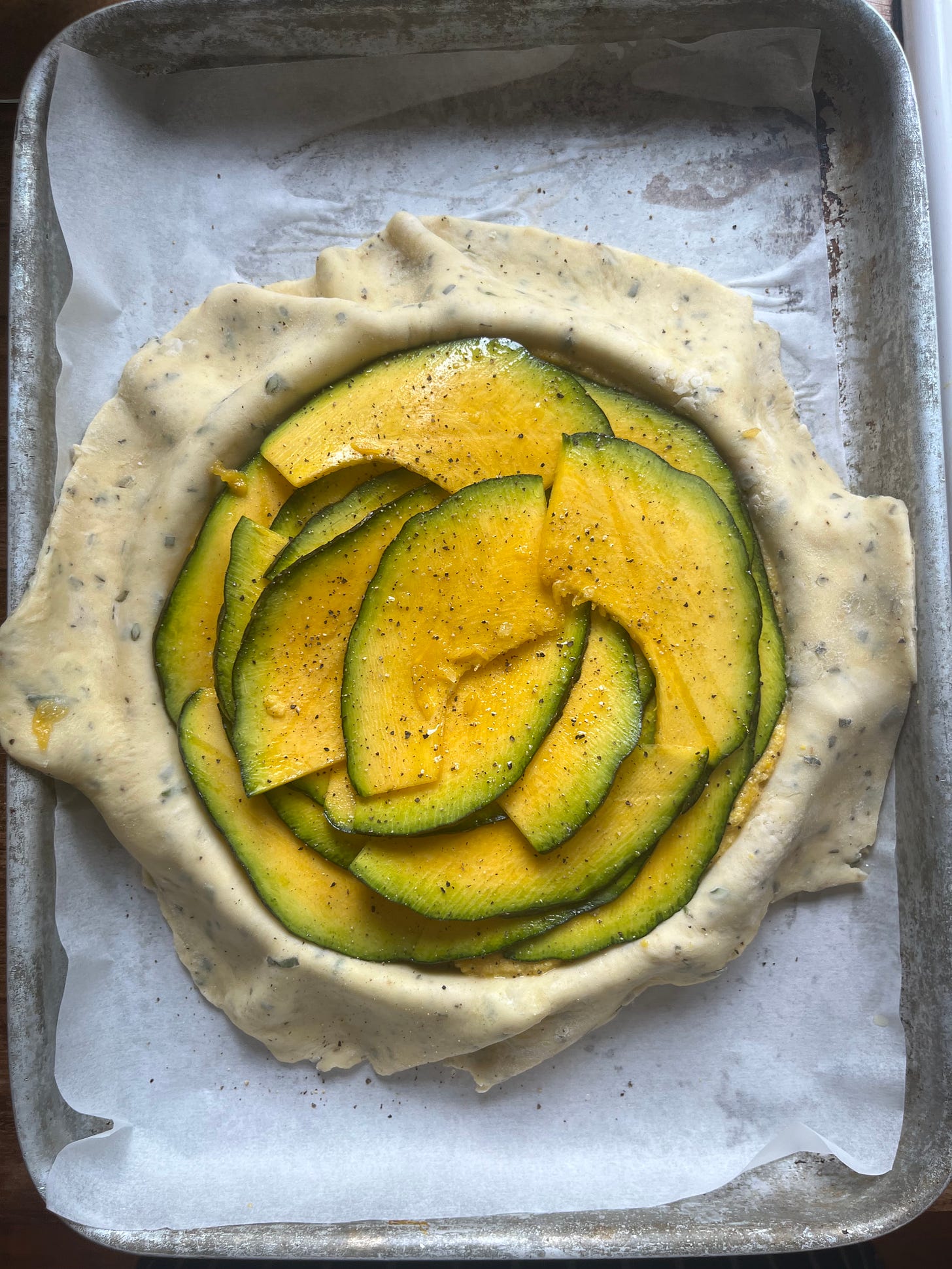
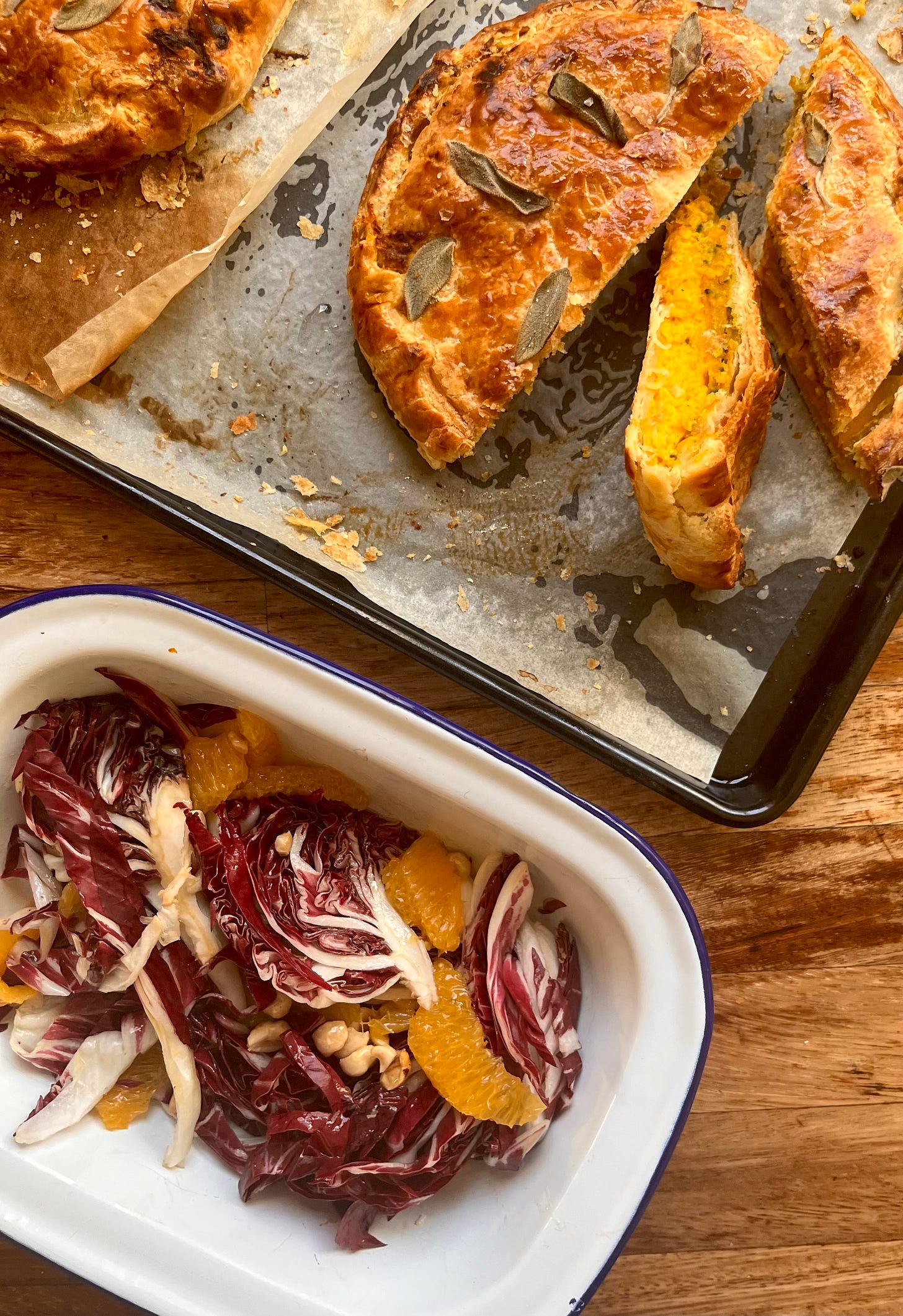
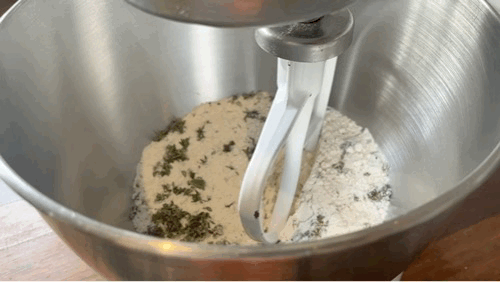
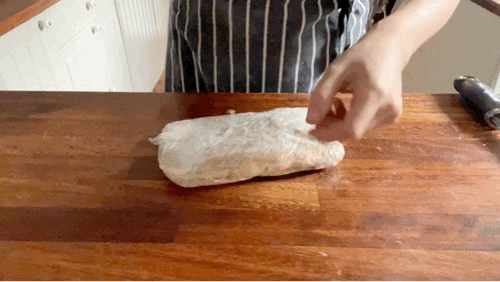

"pumpkin seeds in their shells aren’t great to eat, and they are really difficult to shell yourself" - it had to be said. And I don't care how many articles there are on "don't waste your jack o'lantern trimmings", it's impossible to make them tasty and you can't make them like the nice hulled pumpkin seeds you buy. It's putting lipstick on a pig. Compost and move on.
Proper culinary pumpkins are so delicious and forcing yourself to eat the pulp from decorative gourds just gives them a bad name.
Excellent recipe! Made it for supper tonight. I used roasted Hubbard squash.